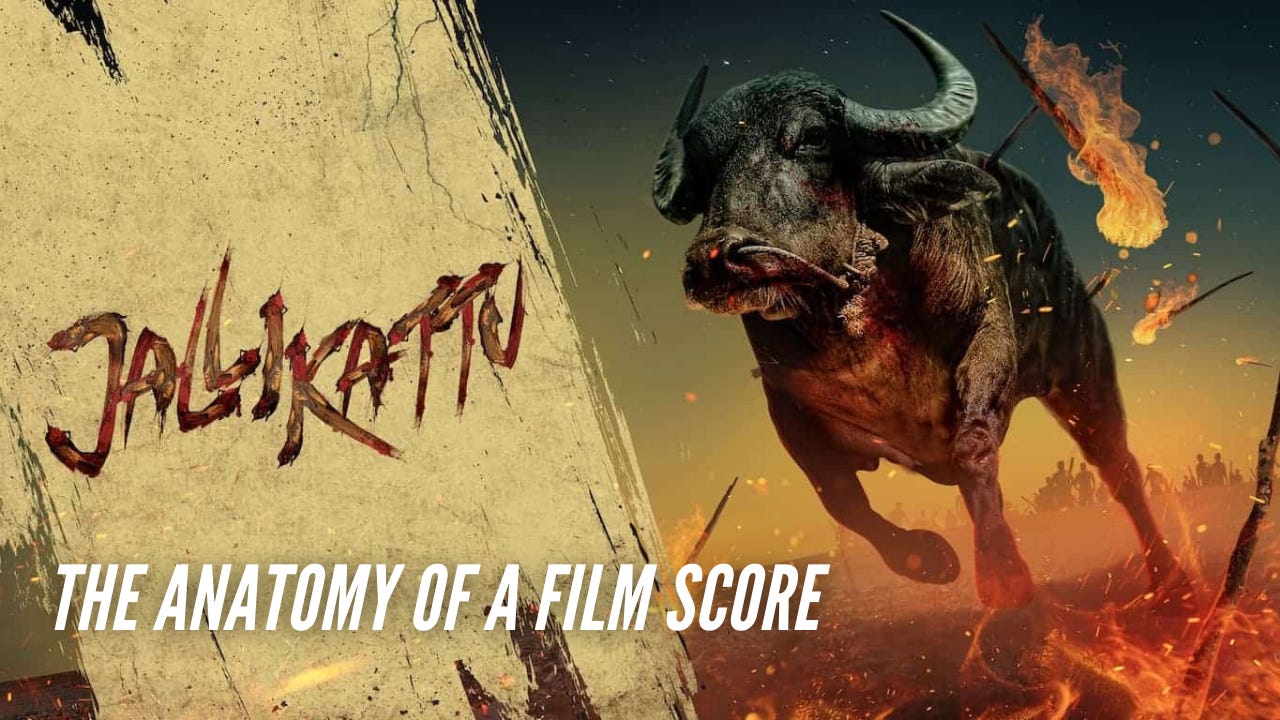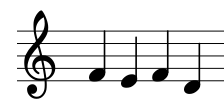Let’s begin with the story of these four notes.
If you like movies, you have probably heard this piece of music before. This is the starting passage of Dies Irae, a 13th-century Gregorian chant about the day God judges humanity and decides between heaven and hell for afterlife. Once commonly used at funerals, it translates from Latin as The Day of Wrath. With the spread of Catholic culture, this chant was eventually interpreted into musical form.
In the days of early cinema, theatres used to have a live orchestra to accompany the film. Growth in recording technology opened the doors to dubbed audio and background music. All this time, Dies Irae has been a popular thematic shorthand for dark and morbid scenes, especially those involving death. If not through the verbose sound of violins or horns, it would play as a descending movement on the contrabass or the cello, implying doom as the audience was distracted by something else.
Lion King is one of the most popular films to use this sequence. In that heart-wrenching scene of Mufasa’s death, the brass section in the background plays Dies Irae. We did not have or need this information to get moist eyes while watching it. And that’s what makes the score so iconic. It creates a great ambience within which pictures can tell the story. As an aside, Lion King remains the only score for which Hans Zimmer has received an Oscar.
Implication through cadence is a crucial cog in film music composition. In a musical context, cadence is the sound that two notes make when played after each other. For example, C(Do) and F(Fa) sounds very different to C(Do) and A(La). Some cadences sound comforting, while some others, like the Dies Erae, are discordant. Fun fact: The C to F-sharp interval was once considered so dissonant, Catholic churches banned its usage, calling it the sound of Lucifer.
Most background scores are paintings on this canvas of intervals and cadences. Jallikattu took that canvas, put it into the incinerator, and made music from the sound of fire.
**
For the final weekend of 2020, I drove down with a group of friends from Chennai to Kodaikanal. It was typically cold and misty, a welcome break from the stuffy moisture of a coastal city. Thankfully, it was also empty enough to make a mid-pandemic trip feasible. After lunch on New Year’s day, tired from the previous night’s drinking, we decided to tuck into blankets and watch a movie. The poster of Jallikattu showed up on Amazon Prime’s home screen. The movie had been in the news for a long time, accumulating gushing reviews from all corners.
Prime showed it as 90 minutes long. It took me less than five to realise we couldn’t have chosen better. The plot was simple, the setting followed suit, but the storytelling, camerawork, and music sent my jaw crashing to the ground. I have watched it in full a few more times since. Invariably, I find it difficult to move from my chair once I hit play. The most recent re-watch convinced me that we need to talk about the background score.
But first, a quick digression. It is my earnest attempt to pique your interest in this movie, just in case you haven’t watched it yet. Before the thought of caution even comes to mind, I assure you there are no spoilers. Just do yourself one favour — don’t listen to the score on YouTube or Spotify. Not to sound esoteric, but it is incomplete without the visual context.
Right. The sounds come before the pictures. Around one minute in, as some initial credits are still rolling in white text over a black background, you hear the tick of a clock. This clock is the lede, the first line, so to speak. Time plays an important part in Jallikattu.
The movie begins with people sleeping inside a dimly-lit room. They open their eyes and exhale to the ticking clock, but in metronomic motion. Not a millisecond offbeat. It is unnerving, like someone snapping their fingers close to your ear while you are breathing or walking. We probably do these things in tempo anyway, but the verbosity makes it uncomfortable.
The tension of the scene rises to its peak before breaking with an exhale. A highly-reverberant human exhale that rings in your ears for two long seconds before fading out. I almost clapped.
This sequence alone could be cut into a video package and sent to film schools. The sound design has conveyed everything it needed to without needing as much as a single note of music. Tension is essentially a function of activity over time. The use of clocks and human breath to show stretch and release seems intuitive in hindsight, but it is an incredible thought to use them as isolated hooks.
Over the first ten-odd minutes, you are told about this village in Kerala and the people around whom the movie revolves. It is an audio-visual experience, honestly. You are shown all kinds of sights and sounds in deep, minute detail, but without the movie ever releasing its grip on your senses.
Behind those quickly-cut frames, you hear the lightning and the river in their raw form. There is no effort to imply their presence with a booming drum or a harp. You hear flies swarming over food, crickets chirping at dusk, the thud of a meat knife cutting through beef and landing on a wooden log. Usually, these sounds are placed somewhere near the bottom of a mix to create a light ambience. In Jallikattu, they are amplified and placed in different parts of a stereo field, giving you a full sonic layer to experience the film through.
Even the main theme, a two-note sequence accompanying the story’s major conflict, is written on some sort of a didgeridoo — a long wind instrument. You hear the breath whenever that theme plays. It keeps coming back, played with the same instrument but in different rhythms.
The dialogues, which are sparse up till the point of the first reveal, are carefully mixed to create a three-dimensional effect, putting you bang in the middle of a circle of irate farmers and shopkeepers. This high-pitched human chatter is placed on a bed of street noises, which makes the whole thing sound even more real.
There is a scene near that reveal, where the entire village runs towards a growing flame. All you hear is the chatter and the whoosh of the fire. There is no accompanying music nudging you to feel what the story wants you to. The composer has taken away the curtain between the pictures and their sound. You are, instead, served the real thing.
With any good film, you feel invested in the story and crave resolution. Throughout Jallikattu, you feel an intense proximity to the elements of that village. It doesn’t feel like you are watching the story play out from someone else’s perspective. You find yourself immersed in the event, as if you are personally impacted, and it is impossible to miss that the sound design is helping you navigate.
Of course, this is not the first film to go earthy with music. In recent times, Ludwig Göransson recorded a chant by Senegalese folk singers to create T’Challa’s theme in Black Panther. Closer home, Sneha Khanwalkar’s work in Gangs of Wasseypur was outstanding in its use of voice. That said, in my limited viewing, I don’t remember encountering too many movies with such a pronounced stripping away of musical conventions.
Jallikattu’s IMDB page shows Prashant Pillai as the composer, and an eleven-member sound department. I don’t know if awards can do their work justice — they haven’t won any yet — but the movie’s success is as much theirs as it is of the writers and cinematographers.
**
When the idea of music to picture was conceived, orchestral instruments were the most commonly accessible. So they became the characteristic sound of films. To this day, composers hold the orchestra close to their chest. How can you not? It is an all-encompassing toolbox.
A solo violin line can make you shed tears in Schindler’s List; you get the creeps when that violinist scratches the strings with the wood of his bow in Psycho; and Bruce Wayne turns into Batman when the tempo rises and staccato cellos march in with heavy percussion. John Williams used the same instruments for a bloody T-Rex.
Directors gravitate towards that sound, too. Beyond everything else, it is a safe palette. It just works. Jallikattu sidesteps all of that and composes a background score out of things that surround its characters. I wonder if music can get more organic than that. Come to think about it, Dies Irae would sound much creepier if you heard the actual chant, wouldn’t it?
I feel that strong experiences often have the power to change perspective. Jallikattu has ensured I never think about film scores the same way again.
I am in the middle of composing a short score for a competition. The video is from an animated movie set in a jungle. The rules demand that I use some sort of orchestral instrumentation, but I am thinking some firefly chirps and creaking wood noises on the side wouldn’t go amiss.






Really enjoyed reading this! Other than the occasional notable theme, the role of sound in movies is often ignored. Will definitely watch (and listen to!) the movie now.
This was filled with sharp observations and was rich in content. Thank you Sarthak. I really hope you continue writing more about films from the audio perspective. I haven't read many posts like this one where sound has become the front and center of the experience of viewing (as a result of what you saw and experienced). I have not seen any movie you have mentioned and will not watch this either but after such a fabulous write up, do I even need to?
Keep writing Sarthak and thank you for this post